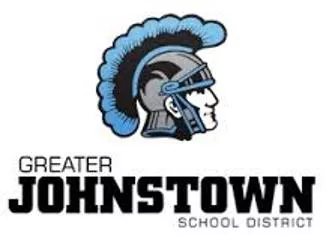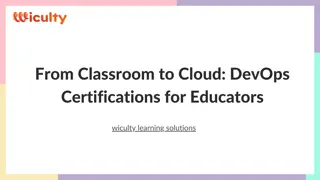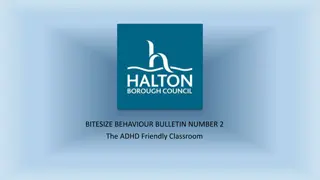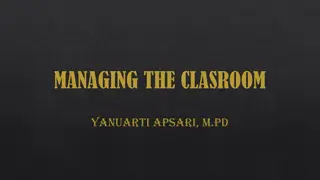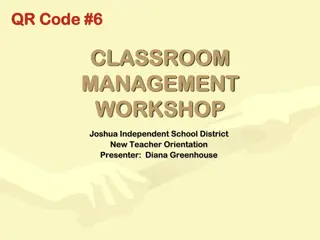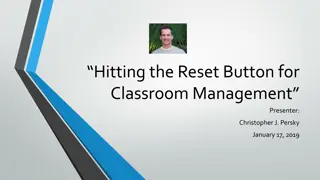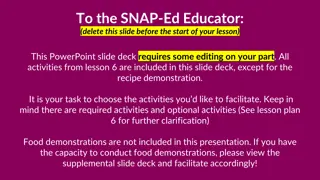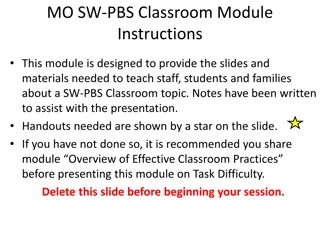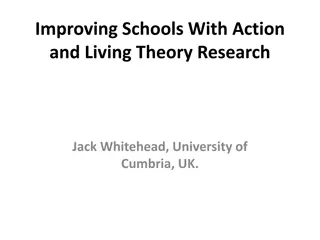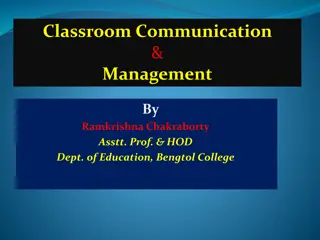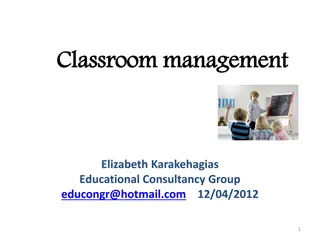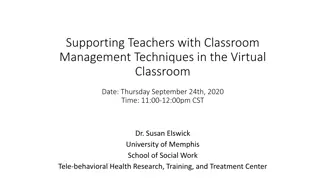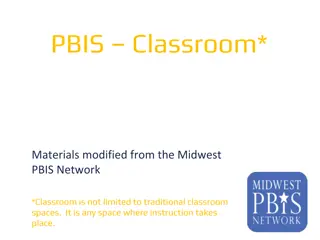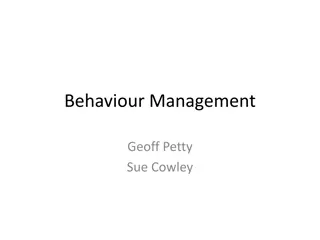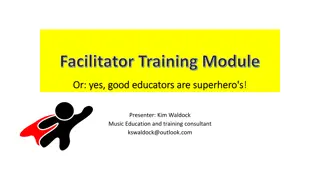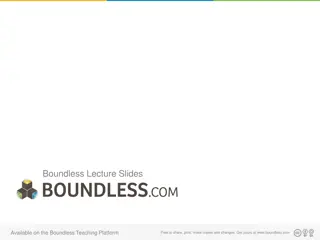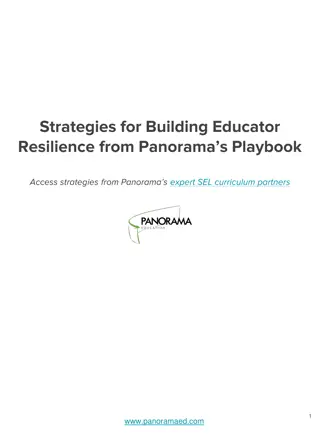Effective Classroom Management Strategies and Importance for Educators
Classroom management is crucial for teachers to create a positive and effective learning environment. It involves setting clear expectations, promoting engagement, and addressing disruptive behavior proactively. Lack of effective classroom management can lead to educator dissatisfaction and student disengagement. Strategies such as implementing checklists, sharing resources, and coaching colleagues can help support a strong classroom management system. Understanding the difference between discipline and management is key in fostering a conducive learning environment.
Download Presentation

Please find below an Image/Link to download the presentation.
The content on the website is provided AS IS for your information and personal use only. It may not be sold, licensed, or shared on other websites without obtaining consent from the author. Download presentation by click this link. If you encounter any issues during the download, it is possible that the publisher has removed the file from their server.
E N D
Presentation Transcript
CLASSROOM MANAGEMENT Tips and Techniques
LEARNING EXPECTATIONS EXPECTATION BEHAVIOR Take ownership of your learning Be open to learning new strategies (Growth Mindset) Be Responsible Turn cell phones off or to vibrate Listen to others attentively by staying quiet while they are speaking Share your questions with the group Use appropriate language Be Respectful Ask what you need to know to understand and contribute Contribute to the team by sharing relevant information and ideas Be Engaged
OBJECTIVES Today we will: Learn about the essential components needed for a positive and effective classroom management system. Learn ways to support your colleagues with their classroom management practices through the use of implementation checklists, resource sharing, and coaching. Review an example of a proactive classroom management plan. Explore a variety of evidence-based, free resources to support proactive classroom management.
WHYIS CLASSROOM MANAGEMENT IMPORTANT? A common concern among beginning teachers is that they lack the skills to address disruptive behavior. (Oliver & Reschly, 2007; Jones & Jones, 2007) Though classroom management remains an important concern among almost all new teachers, many preservice teachers consider the amount of instruction they receive on the topic to be insufficient. What instruction they do receive they tend to see as overly abstract or too divorced from a realistic classroom setting. (Siebert, 2005) In a special analysis of data collected from teachers by the U.S. Department of Education, 53% of teachers who transferred to another school reported student behavior as their reason for doing so, and 44% of those who left the profession reported this as a reason for leaving. (U.S. Department of Education, 2005)
SOBERING CONSIDERATIONS Student problem behavior is cited by the U.S. Dept of Education as one of the top three reasons why educators leave the field. Student problem behavior is one of the top two content areas identified by teachers (a) as an on-site training need, and (b) as a gap in their pre-service training.
DISCIPLINEV. MANAGEMENT Discipline: The reaction to misbehavior AFTER it has occurred. Management: Actions that prevent misbehavior from occurring. Management is identifying the problem and searching for the solution.
DEVELOPINGPOSITIVERELATIONSHIPSWITH YOURSTUDENTSCANMEAN... Less work engaging students. Easier classroom management. Longer focus time. Students will be willing to take risks. Research indicates teachers who have positive relationships with their students report approximately 31% less behavior problems in their classrooms (Marzano & Pickering, 2003).
WAYSTO BUILD POSITIVE RELATIONSHIPS Greet everyone at the door. Call on everyone equitably. Give specific praise. Seek first to understand the student s point of view. Listen and communicate. Show personal interest in student activities. Provide individual help. Respect your students. Be fair. Be consistent. Be kind and courteous. Caring is key.
RESEARCH FINDINGS: EFFECTIVE CLASSROOM MANAGEMENT CRITICAL FEATURES Maximize structure Post, teach, reinforce and monitor expectations Actively engage students in observable ways Use a continuum of strategies to respond to appropriate behavior Use a continuum of strategies to respond to inappropriate behavior 80% Prevention Simonsen, Fairbanks, Breisch, Myers & Sugai (2008)
Ways to Maximize Structure We never educate directly, but indirectly by means of the environment. --- John Dewey (1944)
MAXIMIZESTRUCTUREINYOUCLASSROOM Develop Predictable Routines Teacher Routines: volunteers, communications, movement, planning, grading, etc. Student routines: personal needs, transitions, working in groups, independent work, instruction, getting materials, homework, etc. Design environment to elicit appropriate behavior, minimize crowing and distraction: Arrange furniture to allow easy traffic flow. Ensure adequate supervision of all areas. Designate staff and student areas. Seating arrangements (groups carpet, etc.) Classroom Architect
ASSESS Complete item for your own classroom (or a teacher with whom you consult) 1) I maximized structure and predictability in my classroom. a)I explicitly taught and followed predictable routines. a)I arranged my room to minimize crowding and distraction. Yes No Yes No
ACTION PLAN Generate action plan content (observable and measurable behaviors to address deficits) Potential action plan items may include: Describe predictable routine for entering classroom, turning in homework, (or others that are identified as missing) Rearrange furniture to ensure better supervision # Current Level of Performance Enhancement/Maintenance Strategies[1] 1 [1] What? When? How? By When?
SECTION 2 Post, Teach, Review, Monitor Expectations
Problem Behavior
POST, TEACH, REVIEW, MONITOR, AND REINFORCEASMALLNUMBEROFPOSITIVELY STATEDEXPECTATIONS Establish behavioral expectations/rules. Teach rules in context of routines. Prompt or remind students prior to entering natural context. Monitor students behavior in natural context and provide specific feedback. Evaluate effect of instruction review data, and make decisions, and follow up. Integrate SWPBIS Expectations and Cool Tools!
Integrate SWPBIS classroom expectations into your routines/procedures SWPBIS
TEACH RULESINTHE CONTEXTOF ROUTINES Teach expectations directly. Define rule in operational terms tell students what the rule looks like within routine. Provide students with examples and non-examples of rule-following within routine. Actively involve students in lesson game, role-play, etc. to check for their understanding. Provide opportunities to practice rule following behavior in the natural setting.
GREATER JOHNSTOWN SCHOOL DISTRICT BEHAVIORALLESSONPLANSFOR SWPBIS May be a lesson that you teach as a teacher (e.g., Cool Tool) May be a video demonstrating behavioral expectations
ASSESS 2) I posted, taught, reviewed, monitored, and reinforced a small number of positively stated expectations. Yes No a) I operationally defined and posted a small number of expectations (i.e., school wide rules) for all routines and settings in my classroom. Yes No b) I explicitly taught and reviewed these expectations in the context of routines. c) I prompted or pre-corrected students to increase the likelihood that they will follow the expectations Yes No Yes No d) I actively supervised my students.
MINI ACTION PLAN Generate action plan content (observable and measurable behaviors to address deficits) Potential action plan items may include: Choose three expectations and create posters Complete matrix Develop lesson plans # Current Level of Performance Enhancement/Maintenance Strategies[1] 2 [1] What? When? How? By When?
SECTION 3 Actively Engage Students in Observable Ways
ACTIVE ENGAGEMENT Provide high rates of opportunities to respond Vary individual v. group responding Increase participatory instruction (enthusiasm, laughter) Consider various observable ways to engage students Written responses Writing on individual white boards Choral responding Gestures Technology (Plickers, Kahoot) Other: ____________
RANGEOFEVIDENCE-BASEDPRACTICESTHAT PROMOTEACTIVEENGAGEMENT Direct Instruction Computer Assisted Instruction Class-wide Peer Tutoring Guided notes Response Cards
ASSESS 3) I actively engaged students in observable ways. Yes No a) I provided a high rate of opportunities to respond during my instruction. b) I engaged my students in observable ways during teacher directed instruction (i.e., I use response cards, choral responding, and other methods). c) I used evidence based methods to deliver my instruction (e.g., Direct Instruction). Yes No Yes No
MINI ACTION PLAN Generate action plan content (observable and measurable behaviors to address deficits) Potential action plan items may include: Ask a colleague to take data on my current rate of OTRs and increase by 10% Use response cards during 1 additional lesson per day # Current Level of Performance Enhancement/Maintenance Strategies[1] 3 [1] What? When? How? By When?
SECTION 4 Continuum of Strategies to Acknowledge Appropriate Behavior The goal of reinforcement is to develop desirable behavior rather than to control misbehavior. The emphasis, where misbehavior occurs, is on pressuring to change, not on exacting retribution. --- Jere Brophy (1988, p.12).
ACKNOWLEDGEAPPROPRIATE BEHAVIOR Specific and Contingent Praise Token Economy
ACKNOWLEDGING APPROPRIATE BEHAVIOR Classroom Continuum: Level 1 = Free and Frequent Use everyday in the classroom Level 2 = Intermittent Awarded occasionally Level 3 = Strong and Long Term Quarterly or year long types of recognition
WHEN DO YOU ACKNOWLEDGE? As much as possible! 4:1 Meeting behavioral expectations I love seeing those hands raised! Small changes Repeat a behavior Great job solving the problem by talking. I m thrilled that you arrived on time.
MONITOR STUDENTS BEHAVIORIN NATURAL CONTEXT Active Supervision (Colvin, Sugai, Good, Lee, 1997): Move around Look around (Scan) Interact with students Provide reinforcement and specific praise to students who are following rules. Catch errors early and provide specific, corrective feedback to students who are not following rules. (Think about how you would correct an academic error.)
Teachers Desk Fewer problem behaviors with this pattern
ASSESS 4) I used a continuum of strategies to acknowledge appropriate behavior. a) I provided specific and contingent praise for academic and social behaviors (e.g., following expectations). b) I also used other systems to acknowledge appropriate behavior (group contingencies, behavior contracts, or token economies). Yes No Yes No
MINI ACTION PLAN Generate action plan content (observable and measurable behaviors to address deficits) Potential action plan items may include: Ask a colleague to take data on my current rate of specific and contingent praise and increase by 20% Implement an additional reinforcement system to increase appropriate behavior # Current Level of Performance Enhancement/Maintenance Strategies[1] 4 [1] What? When? How? By When?
SECTION 5 Continuum of Strategies to Respond to Inappropriate Behavior When discipline problems occur, the challenge to the teacher is how to intervene in a manner which encourages continued positive growth and, at the same time, restores appropriate student behavior. To the extent that these interventions are preplanned and systematic, rather than shooting from the hip and arbitrary, the probability of their effectiveness is increased. --- James Levine and John Shanken-Kaye (1996, p.105)
PLANTORESPONDTO MISBEHAVIOR Important concepts: Being prepared for misbehavior reduces annoyance and frustration Correction procedures are only effective if they reduce the future occurrence of misbehavior All behavior (appropriate and inappropriate) serves a purpose
PLANTO RESPONDTO MISBEHAVIOR Establish consequences that fit the nature of the problem, but are as mild as possible Implement consequences calmly and consistently Ideally, consequences should be implemented immediately in the setting in which the infraction occurs
PLANTO RESPONDTOMISBEHAVIOR When you treat student misbehavior as an instructional opportunity, you give students the chance to learn from their mistakes.
RESPONDTOINAPPROPRIATE BEHAVIOR Error Corrections Performance Feedback Planned Ignoring Differential Reinforcement
ASSESS 5) I used a continuum of strategies to respond to inappropriate behavior a) I provided specific, contingent, and brief error corrections for academic and social errors. b) In addition, I used the least restrictive procedure to discourage inappropriate behavior (differential reinforcement, planned ignoring, response cost, time out) Yes No Yes No
MINI ACTION PLAN Generate action plan content (observable and measurable behaviors to address deficits) Potential action plan items may include: Ask a colleague to take data on my current rate of corrective statements and ensure that this rate is far lower than my rate of praise statements Review the consequences I give and ensure I am using the least restrictive procedures possible # Current Level of Performance Enhancement/Maintenance Strategies[1] 4 [1] What? When? How? By When?
RESOURCESTO SUPPORT EFFECTIVE CLASSROOM MANAGEMENT
CLASSROOM MANAGEMENT SELF-ASSESSMENT (SIMONSENETAL., 2008)
CLASSROOM MANAGEMENT PLAN Six Key Principles: Invest time planning at the front end Teach well using quality instructional practices Focus on positive behaviors Provide supports Be educative, not vindictive Be persistent and consistent Vanderbilt University: IRIS Center Classroom Management Module 1
RESOURCES www.papbs.org PA Positive Behavior Support Network Administrator s Toolkit www.interventioncentral.org Intervention Central Administrators Toolkit, PaTTAN www.pbis.org PBIS OSEP
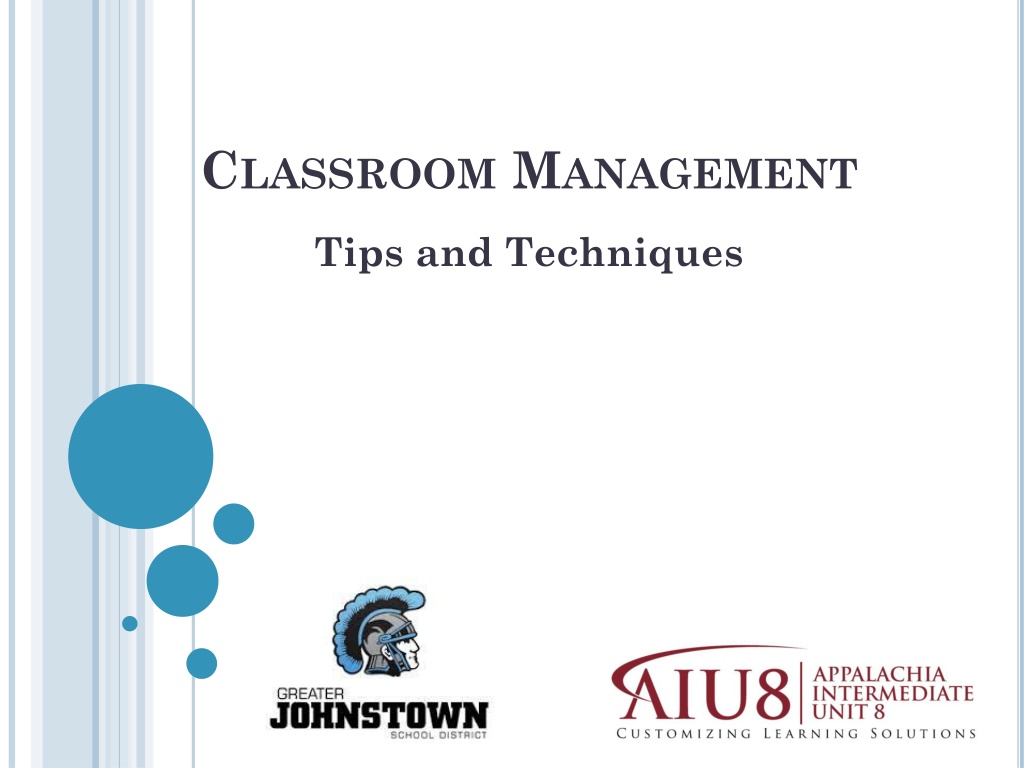
 undefined
undefined
















